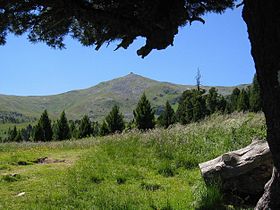Zirbitzkogel
| Zirbitzkogel | |
|---|---|

The Zirbitzkogel with the Zirbitzkogelhaus
|
|
| Highest point | |
| Elevation | 2,396 m (AA) (7,861 ft) |
| Prominence | 1,502 m ↓ Neumarkt Saddle |
| Isolation | 33.2 km → Seckauer Zinken (Seckauer Tauern) |
| Listing | Ultra |
| Coordinates | 47°03′00″N 14°34′00″E / 47.05°N 14.5666667°ECoordinates: 47°03′00″N 14°34′00″E / 47.05°N 14.5666667°E |
| Geography | |
| Location | Styria, Austria |
| Parent range | Seetal Alps |
| Climbing | |
| Normal route | walk |
The Zirbitzkogel, at 2,396 m (AA), is the highest point of the Seetal Alps in Austria. It lies south of the Upper Mur valley in the Styria near its border with Carinthia. The Lavant, a left tributary of the Drau, has its source on the southern slopes of the mountain.
Its name is not derived, as popularly supposed, from the Swiss pine trees (known in German as Zirben) that dominate the woods in places, but from the Slovenian word zirbiza, that can be translated as "red mountain pasture", which is a reference to the red-petalled alpenrose (Rhododendron ferrugineum) that is common hereabouts. In the local region this rhododendron plant is also known as Almrausch ("alp delirium"), perhaps an indication of the toxicity of the plants.
The summit block of the Zirbitzkogel is formed of crystalline rock; slate, gneisses and granites predominating. In spite of its comparatively low height it exhibits a definite high mountain character. Its relief was formed by ice age glaciers and subsequent slope movements. In the very spring-rich region are several tarns, such as the two Winterleitenseen.
Dense spruce forests cover the slopes up to the subalpine zone before being succeeded by scattered stands of spruce, larch and Swiss pine (Swiss pine-larch forest). In the summit area a ragged sedge grassland dominates, interspersed with almost level plateaus. The summit became well known to ornithologists as a breeding habitat for the dotterel, a few pairs of which bred almost all year round until 1995. Thereafter no more broods were sighted, although individual migrants and roosting birds were observed. Wind-exposed spots are dominated by Alpine Azalea and various lichens.
...
Wikipedia

